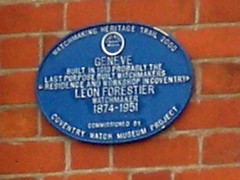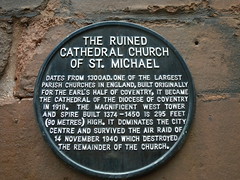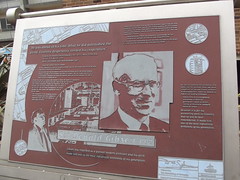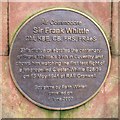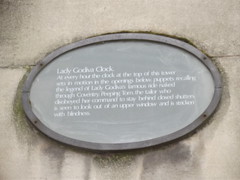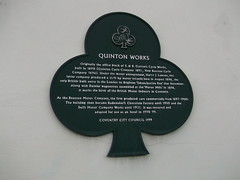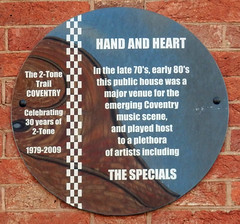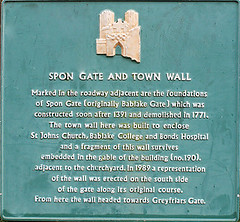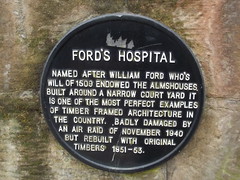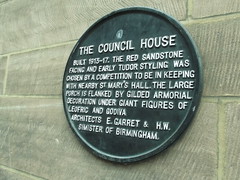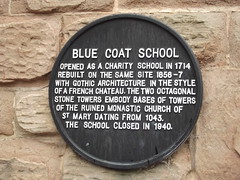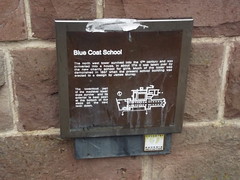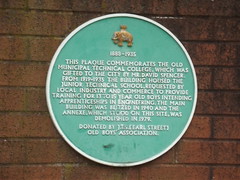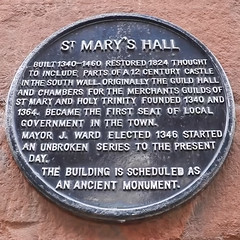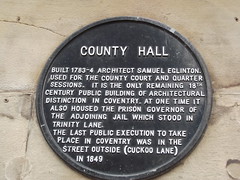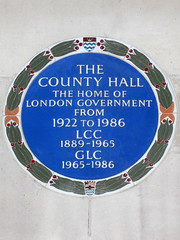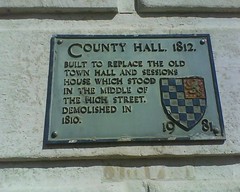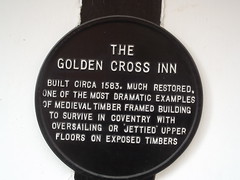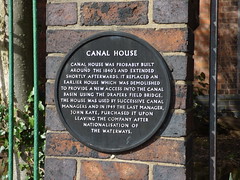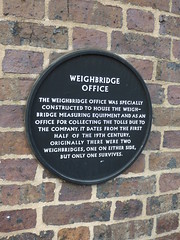Places, subjects, or plaques matching "Coventry"
13 organisations matching "Coventry"
Coventry Watch Museum Project
22 plaquesDiocese of Coventry
1 plaqueCity of Coventry Corporation
1 plaqueCoventry Phoenix Initiative
1 plaqueCoventry Heritage Plaques
3 plaquesCoventry Society
1 plaqueCoventry and District Samaritans
1 plaqueCoventry University
1 plaqueCoventry City Council and Unite
1 plaqueCoventry City Council & UNITE
1 plaqueCoventry Music Museum
1 plaqueCoventry City Council
20 plaques1 place matching "Coventry"
21 subjects matching "Coventry"
(1385-1781) gate

(1509-present) almshouse
(1423-1900) gate
(1300-1940) church
(1913-present) council house

(1823-1896) poet
(1344-present) school
(1880-1938) company
(1937-2002) theatre
(1714-1940) blue coat school
theatre royal
charity
church
(1888-1935) college
(1340-present) guild hall
(1783-1988) county court
(1506-present) almshouse
(1583-present) inn
(1840-present) canal house
toll house

canal
45 plaques matching "Coventry"
This is one of the very few surviving three-storey jettied buildings of Coventry. It dates from 1500 and was formerly at 8-10 Much Park Street next to the present 9 Spon Street. It's semi-detached plan is also notable. As a medieval city centre building it is larger and richer than the indigenous Spon Street buildings. It had a parallel hall range at the rear of two-storey height of which one bay, with a hearth in the middle of the floor. Was open on the roof while the other had an upper floor. The range was too fragile to restore but number 9 has exactly the same range. In the front range the fire-place (FP) were of a later period and were not preserved. The spiral stairs (slightly altered). The carved lintel above this plaque was and in the cellar which was earlier in date than the buildings. The building was dismantled and restored between 1970 and 1974 by the City Corporation with the aid of gifts.
Frank Harvey - 163-164 Spon Street, Coventry, United Kingdom
Subjects
Erected by the Employees of The Coventry Chain Co In Memory of their 45 comrades who fell in the Great War 1914-1918
The Koco Building, Arches Industrial Estate, Spon End, Coventry, United Kingdom
35 Mount Street one of the workshops of the Coventry Co Operative Watch Manufacturing Society Ltd set up by local watchmakers in 1876 about 1900 they moved to Stanley Terrace and ceased trading in 1918
35 Mount Street, Coventry, United Kingdom
Geneve, built in 1910 probably the last purpose built watchmakers residence and workshop in Coventry, Leon Forester watchmaker 1874 - 1951
108 Earlsdon Avenue South, Coventry, United Kingdom
THE PHOENIX by GEORGE WAGSTAFFE 1962 This sculpture which symbolises the rebuilding of Coventry was unveiled May 1962 by H.R.H Princess Margaret. Re-cast in bronze 1983, and unveiled June 1984 by the Right Worshipful the Lord Mayor of Coventry, Councillor W.S. Brandish JP re-sited her in 1987
Hertford Street, Coventry, United Kingdom
The ruined cathedral Church of St Michael. Dates from 1300AD. One of the largest parish churches in England, built originally for the Earl's half of Coventry, it became the cathedral of the Diocese of Coventry in 1918. The magnificent west tower and spire built in 1374-1450 is 295 feet (90 metres) high. It dominates the city centre and survived the air raid of 14 November 1940 which destroyed the remainder of the church
St Michael's Avenue, Coventry, United Kingdom
Subjects
Coventry Canal Basin It was here in 1979 that photographers Chalkie Davies & Carol Starr took a set of iconic images that graced the covers of the first two Specials albums
Canal Basin, Coventry, United Kingdom
Subjects
Coventry Patmore 1823-1896 Poet and essayist lived here 1858-1860
Highwood Lodge, 85 Fortis Green, London, United Kingdom
Subjects
The Architect's Vision Gibson and Coventry were seen to be pioneers in urban planning as the radically different face of their city centre took shape. 'One of the finest shopping centres in the world' The shopping precinct in Coventry has been recognised as a model for a number of similar centres throughout the world. It was the world's first large scale pedestrianised shopping area. The Planning By the end of the 1930s Coventry had outgrown it's city centre. The population had become far greater than that with which it's still largely medieval central area and road system could cope. It soon became clear that the only adequate answer would be an extensive reconstruction but there was neither the legislation nor the finance available to make this a practical proposition. In 1938, 29 year old Donald Gibson was appointed City Architect. Gibson was the first architect Coventry had ever had. He was filled with a drive and enthusiasm to experiment and also a care for the way people should live. He was surrounded by a small dedicated team and his grand scheme started to take shape for the redesign of the congested city centre. He believed there was a need to get away from the idea that motor traffic and pedestrians must mix together in a shopping street. Gibson said that pedestrians could move about freely and safely in precincts or arcades. If it had not been for the terrible blitz by the Luftwaffe he may never have had the opportunity to make his ideas a reality. However with large areas levelled by the bombing he had the chance to start with a relatively clean sheet. The Precinct The central theme of his plan was a precinct of shops to which there would be motor access to the rear for service vehicles. The idea was to bring back the comfortable and more spacious days when wondering from shop to shop was not done at the mercy of vehicles. Coventry's pedestrian precinct was designed to be aligned with the cathedral spire of St. Michael's. The use of a spire as an architectural vista was later copied by both Hanover and Japan. Two storey shops were developed in order to get more shops into a smaller walking distance. This tier system was based on Chester's Rows. The precinct was largely completed by the end of 1955. "If you cannot put up buildings of your own time, you might as well forget it. A town must live, you cannot wait until fashions change." Sir Donald Gibson
Upper Precinct Mall, Coventry, United Kingdom
Subjects
Sir Donald Gibson CBE Gibson was regarded as a pioneer modern architect and his work made him one of the most influential architects of his generation. 'He was ahead of his time. What he did astonished the world. Coventry desperately needed his inspiration' Gibson, Sir Donald Evelyn Edward, C.B.E., D.C.L., M.A., P.P.R.I.B.A., D.I.S.T., T.P., M.T.P.I., T.P.I. Born 11th October 1908, Died December 1991 Gibson was Coventry's first City Architect. He was regarded as a pioneer modern architect and his work made him one of the most influential architects of his generation. He may never have the chance to put his ideas into action, but for the terrible bombing. Within a fortnight of the November 1940 Blitz of Coventry, the City Council had set up a re-development committee and along with powerful allies and devoted members were able to begin the drive to rebuild the city. Gibson was the sort of genius who wanted to throw off sparks of imagination and his ideas. He was way ahead of his time, what he did was astonishing and Coventry desperately needed his inspiration. Many people thought that his ideas would sweep away too much of the old city, but his ideas encompassed old details amongst the open spaces and uncluttered views of his new vision. The alignment of the shopping precinct with the cathedral spire was a moment of inspiration that was to be copied by other cities worldwide. Gibson achieved many firsts as the City Architect. Apart from the first pedestrian precinct there was the first rooftop parking, the first postwar civic theatre, the circular retail market and experimental building methods. Planners and architects all around the world came to see what was happening in Coventry. Characteristically Gibson was prepared to acknowledge the fact that given his time again he might do some things differently. "If you cannot put up buildings of your own time, you might as well forget it. A town must live, you cannot wait until fashions change" In 1955 Sir Donald left Coventry, this meant that his personal vision was never completed. He became County Architect in Nottinghamshire, where he worked on radical new building techniques. Gibson went on to a Knighthood and became in effect the government's senior architect, raising architectural standards during his tenure. However it is for his pioneering work in Coventry that he will be best remembered. It made him one of the most influential architects of his generation.
Upper Precinct Mall, Coventry, United Kingdom
Subjects
The Collegiate and Parish Church of St. John the Baptist This church was founded in 1344 by Queen Isabella widow of King Edward II, on land called 'Babblake' and was granted by her to the Guild of St. John the Baptist. It was to be served by two chaplains from the 'College of Bablake'. Those priests were to say a daily mass for, the repose of the soul of her late husband King Edward II, her son King Edward III, her daughter in law Queen Phiippa, her grandson Edward the Black Prince and members of the Guild of St. John. The building was consecrated on 2nd May 1350 to God and St. John the Baptist. By the time of the dissolution of the Guilds in 1548, the church was closed and given to the Mayor of the Corporation. During the time of the Commonwealth (1642-1660), the church was used as a prison for Royalist soldiers captured at the Battle of Preston. As the sympathies of the citizens of Coventry lay with the Parliamentarians, they gave the Royalist prisoners a hostile reception giving rise to the saying 'sent to Coventry', meaning that someone is ignored or treated coldly. After many years lying empty, occasionally being used to hold markets and as a stretch yard for dyed cloth, the Corporation agreed to reopen the church as a place of worship. It was created a Parish Church on 24th July 1734. Today the church serves the spiritual and other needs of this community and the city.
St. John the Baptist Parish Church, Corporation Street, Coventry, United Kingdom
Subjects
Air Commodore Sir Frank Whittle OM, KBE, CB, FRS, FRAes. This statue celebrates the centenary of Frank Whittle's birth in Coventry and shows him watching the first test flight of a jet-propelled Gloster-Whittle E28/39 on 15 May 1941 at RAF Cranwell. Sculpture by Faith Winter unveiled on 1 June 2007
Millennium Place - near Hales Street, Coventry, United Kingdom
Subjects
Lady Godiva Clock At every hour the clock at the top of this tower sets in motion in the openings below, puppets recalling the legend of Lady Godiva's famous ride naked through Coventry. Peeping Tom, the tailor who disobeyed her command to stay behind closed shutters is seen to look out of an upper window and is stricken with blindness.
Hertford Street Shopping, Broadgate, Coventry, United Kingdom
Subjects
Graham Vivian Sutherland O.M., A.R.E. (1908-1980) Sutherland was a major 20th century artist, known for his paintings, etchings and designs. He lived here at “Four Winds” between 1922 and 1924. His paintings and etchings of rural scenes were exhibited at the Royal Academy every year from 1923 to 1930. His important works include the Coventry Cathedral tapestry and portraits of eminent personalities.
Four Winds, Upland Road, Sutton, United Kingdom
Subjects
Swift Quinton Works. Originally the office block of S. & B. Gorton's Cycle Works, built in 1890 (Quinton Cycle Company 1891, New Beeston Cycle Company 1896). Under the motor enterpreneur, Harry J. Lawson, the latter company produced a 11/4 - hp motor tricycle here in August 1896, the only British-built entry in the London to Brighton 'Emancipation Run' that November. Along with the Daimler wagonettes assembled at the 'Motor Mills' in 1896, it marks the birth of the British Motor Industry in Coventry. As the Beeston Motor Company, the firm produced cars commercially from 1897-1900. The building then became Radenaker's Chocloate Factory until 1905 and the Swift Motor Company Works until 1931. It was restored and adapted for use as an hotel in 1998-99.
Parkside, Coventry, United Kingdom
1. This memorial commemorates the work done on behalf of the parish and the people of Stoke by the Conservators of the ancient commons of the parish. The Conservators were in control of the commons from 1889 to 1928, when their duties were taken over by the Corporation of Coventry. Erected in 1933. 2.The Mayor of Coventry (Alderman Fred Lee); Stephen Evans Bayley, Joseph Holt & Charles Payne, councillors for Stoke ward; John Marriott Binley, Arthur Chattaway, Charles Alfred Gray, William Hodgson Malcolm, John Woodward & Robert Wormell; Clerk to the Conservators: Henry Benjamin Sparkes.
Stoke Common, Binley Road, Coventry, United Kingdom
I remember, i remember coming up england by a different line for once, early in the cold new year. we stopped, and, watching men with number-plates sprint down the platform to familiar gates, "why, coventry!" i exclaimed. "i was born here". philip larkin poet and coventrian ( 1922 - 1985 )
Platform 1 - Coventry Station, Coventry, United Kingdom
Subjects
Coventry workers made the world famous Rudge on and near this site 1880-1938. Tricycles-Bicycles-Motorcycles. Patent spoked wheels. Ammunition.
Skydome, Spon Street, Coventry, United Kingdom
Subjects
Hand and Heart. In the late 70's, early 80's this public house was a major venue for the emerging Coventry music scene and played host to a plethora of artists including The Specials
The Hand and Heart, Coventry, United Kingdom
Subjects
Thomas Humber 1841-1910. Engineer, made bicycles, motorcycles and cars here and later in Coventry
Humber Works, Humber Road, Beeston, Nottinghamshire, United Kingdom
Subjects
Greyfriars Gate Bull Yard was formerly a short street (Bull Street) leading to Barrack's Square Market (now Barracks car park), but on Samuel Bradford's 1748-9 Coventry map it was part of a much longer path leading from Greyfriars Gate to Smithford Street, beside the Black Bull Inn - "The Back Way to the Bull". The path was used by the Royalist leader, the Earl of Northampton, to escape from the Inn when troops were outnumbered by Parliamentarian forces in 1642 during the Civil War. "The Bull" a three-storey timber framed building of eight bays, mentioned in the 15th century documents was the Black Bull by the 17th century. A large field belonging to the Inn was called the Bull Field, in 1793 the "Black Bull" was replaced by the Cavalry Barracks, a five bay stone building. The plaque at the Shelton Square entrance to Bull Yard commemorates another "bull",. the Dun Cow slain by Guy of Warwick. In Coventry legend the cow was a huge wild boar, which terrorised the people and rooted up Swanswell (Swine's Well) Pool with it's snout - till Guy slew it. In the paving the outline of the Town Wall is marked: this was built between 1385 and 1391. Also depicted is Greyfriars gate, one of the principal gates out of twelve which once circuited the Wall. It's actual site was in the roadway nearby. In 1648 Royalist soldiers were imprisoned there. In 1705 it was made into a dwelling but was demolished in 1781.
Bull Yard, Coventry, United Kingdom
Subjects
Spon Gate and Town Hall. Marked in the roadway adjacent are the foundations of Spon Gate (originally Bablake Gate) which was constructed soon after 1391 and demolished in 1771. The town wall here was built to enclose St Johns Church, Bablake College and Bonds Hospital and a fragment of the wall survives embedded in the gable of the building (no. 190) adjacent to the churchyard. In 1989 a representation of the wall was erected on the south side of the gate along it's original course. From here the wall headed towards Greyfriars Gate.
Corporation Street, Coventry, United Kingdom
Ford's Hospital Named after William Ford who's will of 1509 endowed the almshouses. Built around a narrow court yard it is one of the most perfect examples of timber framed architecture in the country. Badly damaged by an air raid of November 1940 but rebuilt with original timbers 1951-53.
Ford's Hospital, Greyfriars Lane, Coventry, United Kingdom
Subjects
Hill Street Gate. 'Made new' about 1423, it's original form and construction date are unknown. The town wall on either side was built in the 1390s. The gate was demolished in the latter half of the 19th Century. Bond's Hospital was later extended over the wall and Bond St. opposite laid out directly over another section. The site of the gate is now marked in the roadway adjacent.
Hill Street, Coventry, United Kingdom
Subjects
The Council House. Built 1913-17. The red sandstone facing and early tudor styling was chosen by a competition to be in keeping with nearby St Mary's Hall. The large porch is flanked by gilded armorial decoration under giant figures of Leofric and Godiva. Architects E. Garret & H.W. Simister of Birmingham.
Earl Street, Coventry, United Kingdom
Subjects
Coventry Patmore 1823-1896 poet and essayist lived here 1863-1864
14 Percy Street, Camden, W1, London, United Kingdom
Subjects
The College of Bablake and Bond's Hospital. The site of collegiate buildings of the Church of St John since 1344. The 14th century priests quarters were remodelled in 1560 as a boys hospital and later as a boys school which remained until 1890 when Bablake School transfered to new buildings in Coundon Road. Bond's or Bablake Hospital was endowed by the will of Thomas Bond in 1506. Much restored in 1832-34 it still provides a home for the elderly
Lower Hill Street, Spon End, Coventry, United Kingdom
Subjects
The Coventry Theatre The New Hippodrome, as it was originally named, was opened on 1 November 1937. It was the third Hippodrome on this site, the first situated in Pool Meadow (1903) and the second (1907) built in what is now the lower part of Lady Herbert's Garden. The New Hippodrome, re-named the Coventry Theatre in 1955, provided the venue for some of the world's greatest artistes and productions. The auditorium was comfortable and impressive in size, seating 2136. The arrival of television in the 1950s and '60s caused a drastic decline in the popularity of variety theatre. In 1985 the theatre became a bingo hall and operated as such until it was demolished in 2002 to make way for Millennium Place, the Whittle Arch and the new frontage to Coventry Transport Museum.
Millennium Place - near Hales Street, Coventry, United Kingdom
Subjects
Blue Coat School. Opened as a charity school in 1714 rebuilt on the same site 1856-7 with Gothic Architecture in the style of french chateau. The two octagonal stone towers embody bases of towers of the ruined monastic church of St Mary dating from 1043. The school closed in 1940.
Priory Gardens, Coventry, United Kingdom
Subjects
Blue Coat School The north west tower survived into the 17th century and was converted into a house. In about 1714, it was taken over by the new charity school for girls. Much of the tower was demolished in 1857 when the present school building was erected to a design by James Murray. The lowermost part of the medieval tower does survive and it's exterior is best seen at the bottom of the steps on the next level down.
Blue Coat School - Priory Gardens, Coventry, United Kingdom
Subjects
On this site stood the Theatre Royal where the Salvation Army began its mission in Coventry on the 17th February 1878.
Former BHS - Upper Precinct, Coventry, United Kingdom
Subjects
On this site stood St Michaels Baptist Church from 1856 until November 1940 rebuilt at Quinton park, Cheylesmore, Coventry. New building completed on original foundations.
Bayley Lane, Coventry, United Kingdom
Subjects
1888-1935 This plaque commemorates the old Municipal Technical College, which was gifted to the city by Mr. David Spencer. From 1919-1935 the building housed the Junior Technical School, requested by local industry and commerce to provide training for 13 to 15 year old boys intending apprenticeships in engineering. The main building was blitzed in 1940 and the annexe, which stood on this site, was demolished in 1979.
Little Park Street, Coventry, United Kingdom
Subjects
St Mary's Hall. Built 1340-1460 restored 1824 thought to include parts of a 12 century castle in the south wall. Originally the guild hall and chambers for the Merchants Guilds of St Mary and Holy Trinity founded 1340 and 1364. Became the first seat of local government int eh town. Mayor J. Ward elected 1346 started an unbroken series to the present day. The building is scheduled as an ancient monument
Bayley Lane, Coventry, United Kingdom
Subjects
The Reverend Henry Venn Elliott 1792-1865 founder of St Mary's Hall (1836-2009) and his sister Charlotte Elliott 1789-1871 composer of "Just As I Am" and many other hymns
St Mary's Hall, Brighton, United Kingdom
Subjects
County Hall. Built 1783-4 architect Samuel Eglinton used for the County Court and Quarter Sessions. It is the only remaining 18th Century public building of architectural distinction in Coventry. At one time it also housed the prison Governor of the adjoining jail which stood in Trinity Lane. The last public execution to take place in Coventry was in the street outside (Cuckoo Lane) in 1849.
Cuckoo Lane, Coventry, United Kingdom
Subjects
Texas Historical Marker #11767
Zychlinski Park. Named for the Polish nobleman who came to Brazoria County in the late 1880s and fell in love with the flowering pear trees in an area he called Pearland, Zychlinski Park was included in the original town site. Captain Wilhelm Zychlinski bought 5991 acres of land by a railroad siding switch at a station called Mark Belt. Shortly after completing his town plat, Zychlinski sold most of his holdings and disappeared, leaving his lawyer, J. W. O'Brian, to file the map of Pearland with the county Hall of Records on September 26, 1894. In 1911, land developers Allison and Richey set up offices in the Suburban Gardens Hotel. To promote Pearland, the firm supported a music band and outfitted the Suburban Gardens baseball team. For nearly two generations the people of Pearland played baseball in Zychlinski Park. Old-timers have recalled long Sunday afternoons on the sidelines and overtime games illuminated by car headlights. During the depression era, baseball in the park was a popular escape. Only World War II stopped baseball in Zychlinski Park. In 1946 a group of citizens signed a petition to allow the park to be used by the school district, and until the late 1990s it was the playground of the C. J. Harris Elementary School. (1998) Incise: Pearland Independent School District (1996-1997) James Schleider, superintendent Board of Trustees: Glen Moreau, president; Phil Peevey, vice president; Ed Thompson, secretary; Lilliam Smith; Glenn Garrison; Rosella Webb; Jim Watson #11767
2319 Grand Blvd., Pearland, TX, United States
The County Hall, the home of London government from 1922 to 1986. LCC 1889-1965. GLC 1965-1986
South Bank, London, United Kingdom
Subjects
County Hall. 1812. Built to replace the old town hall and sessions house which stood in the middle of the High Street. Demolished in 1810.
High Street, Lewes, United Kingdom
Subjects
The Golden Cross Inn. Built circa 1583. Much restored, one of the most dramatic examples of medieval timber framed buildings to survive in Coventry with oversailing or 'jettied' upper floors on exposed timbers.
Bayley Lane, Coventry, United Kingdom
Subjects
The Golden Cross An ale house for over 500 years it was a meeting place for Royalists in the Civil War until Shrewsbury was taken by Parliamentarian troops in 1646. Was also sacristy to old church of St.Chad opposite which collapsed in 1788
14 Princess Street, Shrewsbury, United Kingdom
Subjects
On this site formerly stood The Golden Cross Inn the prorietor of which Mr. Richard Ketley founded in or before 1775 the first known building society in the world. This plaque was presented to the City of Birmingham by the International Union of Building Societies and Savings and Loan Associations. President Mr. Morton Bodfish and unveiled by the right worshipful the Lord Mayor of Birmingham Alderman John Joseph Grogan M.B.B.. J.P. 28th March 1958
Old Snow Hill, Birmingham, United Kingdom
Subjects
Canal House Canal House was probably built around the 1840's and extended shortly afterwards. It replaced an earlier house which was demolished to provide a new access into the Canal Basin using the Drapers Field Bridge. The house was used by successive canal managers and in 1949 the last manager, John Kaye, purchased it upon leaving the company after nationalisation of the waterways.
Canal House - Draper's Fields, Coventry, United Kingdom
Subjects
Weighbridge Office The Weighbridge Office was specially constructed to house the weighbridge measuring equipment and as an office for collecting the tolls due to the company. It dates from the first half of the 19th century. Originally there were two weighbridges, one on either side, byt only one survives.
Weighbridge Office - Coventry Canal Basin - Leicester Row, Coventry, United Kingdom
Subjects
Vaults Two large vaults of brick construction, linked at the back, were built into the retaining wall on the north-western boundary of the canal basin in the middle of the 19th century. They were built for coal storage for the nearby gas works, when after 10 years the Coventry Canal Company won back the business from the railways.
Units 1-4 Coventry Canal Basin, Coventry, United Kingdom



